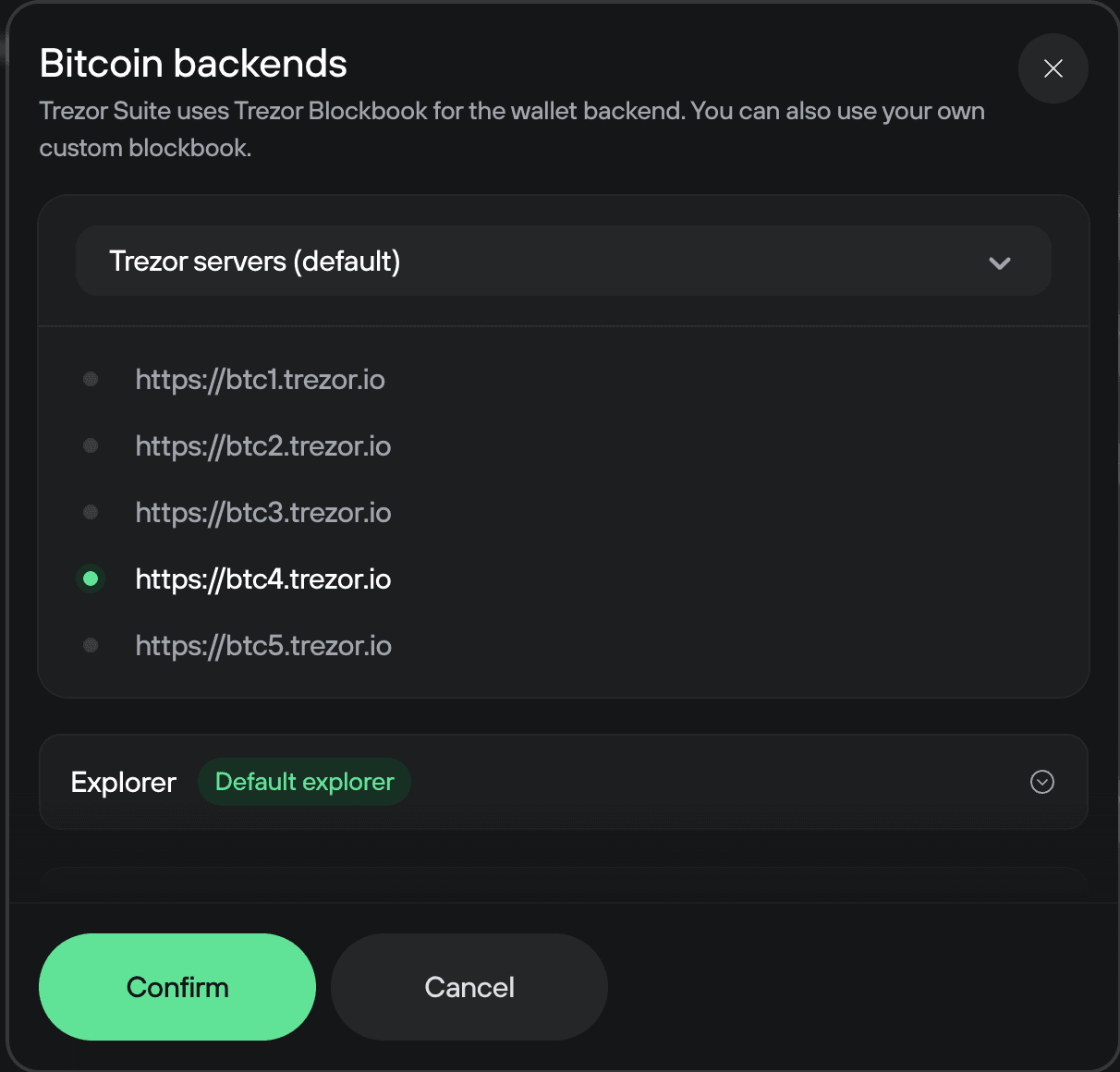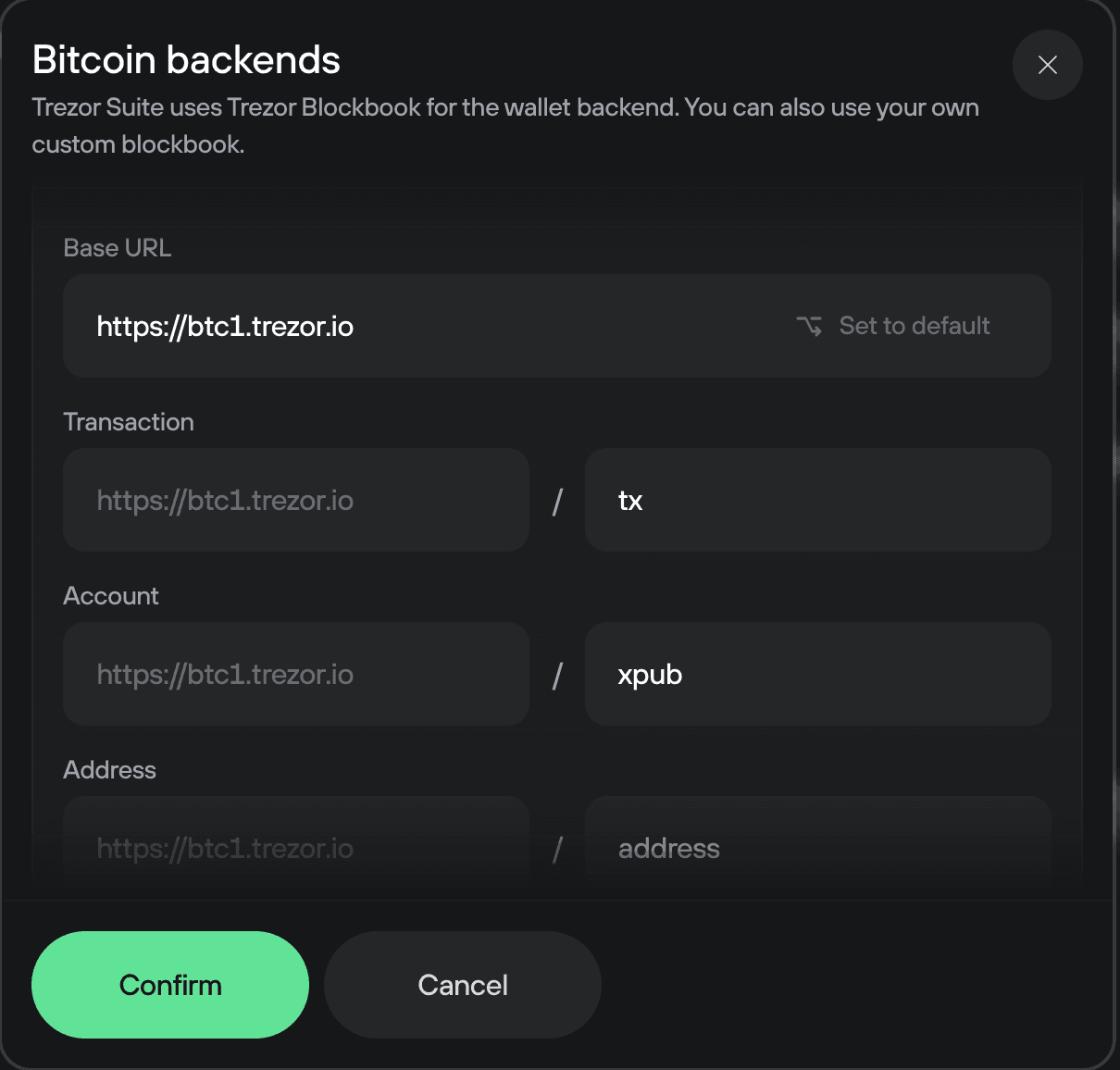Custom backend in Trezor Suite
Running your own node can offer additional peace of mind as personal data are never shared externally. The concept can be too advanced for some users, but don't worry, as it is still completely safe to continue using the default backend settings, which connect Trezor Suite to SatoshiLabs’ nodes. These nodes are run by us and operate on open-source Blockbook software, and do not keep track of user data.
Running a local instance of Trezor Suite
You can run a local instance of Trezor Suite on your computer. Together with a local Blockbook server, you can be completely independent from connecting to SatoshiLabs servers.
How to install a local instance of Trezor Suite
1 - Install Python. (Guide for Windows and Linux)
2 - Download Trezor Suite from https://suite.trezor.io/
3 - Extract it to a new folder and run:
python -m SimpleHTTPServer 8000
For python3 users:
python3 -m http.server 8000
This will run a server at localhost
4 - Open localhost in your browser (Google Chrome or Firefox).
Important: If you decide to rely on a local instance of Trezor Suite, make sure to regularly download the current version using the link above.
Running a local instance of Trezor Suite backend (Blockbook)
You can install and run Blockbook on your computer. With Trezor Suite installed and running as a local instance, you can be completely independent from connecting to SatoshiLabs servers.
To install it on Linux, please use this step-by-step guide:
1 - To install Blockbook, you will need to use Linux Debian version 11 (Bullseye) or later.
Before you start installing Blockbook, please check the latest blockchain size for your cryptocurrency and be sure to have this amount + approximately 60% - 70% of the size of the blockchain for the blockbook available on your hard drive. You will also require a server with sufficient memory (at least 1TB for Bitcoin Mainnet).
Switch to root privileges before proceeding with the installation.
2 - Install docker using this guide:
https://docs.docker.com/install/linux/docker-ce/debian/
3 - Clone blockbook git:
git clone https://github.com/trezor/blockbook
4 - Go to blockbook directory and run:
make all-<coin> (e.g., make all-bitcoin)
5 - Go to blockbook/build directory and run:
apt install ./<package name> (e.g., apt install ./backend-bitcoin_0.16.1-satoshilabs1_amd64.deb)
6 - Now you can start synchronizing with the network:
systemctl start backend-<coin>.service (e.g., systemctl start backend-bitcoin.service)
7 - If you want to check the status of your synchronizing go to /opt/coins/data/<coin>/backend (eg., /opt/coins/data/bitcoin/backend) and check the status in debug.log file.
8 - If the blockchain is fully synchronized, you can start installing your Blockbook. Go to the directory blockbook/build and run:
apt install ./<blockbook package> (e.g., apt install ./blockbook-bitcoin_0.0.6_amd64.deb)
9 - Run Blockbook:
systemctl start blockbook-<coin>.service (e.g., systemctl start blockbook-bitcoin.service)
10 - Blockbook is now synchronizing with your blockchain.
You can check the status in /opt/coins/blockbook/<coin>/logs/blockbook.INFO (e.g. /opt/coins/blockbook/bitcoin/logs/blockbook.INFO) or by visiting https://localhost:<blockbook public port> (e.g., https://localhost:9130 for bitcoin)
11 - After full synchronization, your Blockbook is now running at the localhost port.
Please note that the Mainnet sync and subsequent Blockbook sync can take many hours or even days.
12 - Now you can connect Trezor Suite to your local Blockbook instance by using a custom backend:
- In Trezor Suite, go to Settings, and then select the Coins tab
- Place your cursor on Bitcoin, and click the settings gear icon
- In the Backends window, you can switch from "Trezor servers (default)" to "Custom Blockbook server" using the drop-down menu located at the top of the list of addresses.
- You can then add the backend details from Blockbook settings, and then click on the "Confirm" button to complete the setup
Important: Blockbook uses a self-signed certificate. It is necessary to go to the address in your browser, confirm the certificate, and then add the address to your wallet.
Using a custom block explorer in Trezor Suite
You can set a different block explorer as the default for any supported asset in Trezor Suite.
Go to Settings, then open the Coins tab. Use your mouth to hover over the asset you want to set a custom block explorer for. This will reveal a settings icon. Click it, then select the Explorer option.

This will open a menu which allows you to set the custom block explorer. Scroll down to the field labeled Root URL. Replace the existing URL with the one you’d like to use. If your chosen block explorer uses a unique format for transaction IDs or addresses, make sure to update the formatting fields accordingly. When you’re done, select Confirm.

Your custom block explorer will now be used to view transactions for that asset.